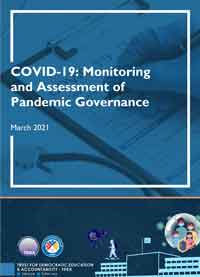- Sustainable efforts needed to increase testing rate, vaccination drive
ISLAMABAD, April 1, 2021: With the increase in number of positive cases during third wave of coronavirus and lax attitude of the general public towards deadly disease, the parliamentary oversight of the government’s COVID-19 response showed signs of improvement but it remained inadequate.
The Standing Committees of the Senate and the National Assembly held their meetings in February to deliberate the alarming situation of the pandemic and the legislators also raised queries seeking information regarding procurement of the vaccines and the vaccination plan but no major decision was taken at the highest public forum.
For generating TDEA-FAFEN’s fifth monitoring report on COVID-19 governance, data was collected from 35 districts following interviews of stakeholders and visits of hospitals from February 1, 2021 to March 15, 2021. The findings of the report underline the urgency for exercising sustained efforts and vigilance in the governance of COVID-19 response as Pakistan transitioned into the third wave of the pandemic. Whereas the overall mortality rate decreased over the reporting period, as did the monthly infection rate for February, the spike in the last week of the previous month and acceleration of new infections in the first two weeks of March reflected the start of the new wave.
The number of active COVID-19 cases surged as third wave of the pandemic gripped the country. The trend from around the end of February was one of increasing infections as well as positivity rate, which grew from 3.6 percent in the first week of February to 5.8 percent in the second week of March.
The third wave followed the lack of compliance with SOPs observed during February. Even at public offices and health establishments, compliance with some of the key SOPs by the staff and visitors registered a decline from the previous month or remained low in February. “Social distancing, for instance, was observed not being followed at 30 percent of the public offices and 34 percent of the healthcare centers.”
Relaxed trends were also observed in other key indicators as well. It was observed that monthly tests in February declined overall to 0.98 million and were the second lowest since the onset of the second wave in November 2020. Reflecting a reactive mode, the number of tests increased from 31,000 per week in the beginning of February to above 40,000 around mid-March.
Administering only 0.16 COVID-19 vaccine doses per 100 people, the vaccination drive in Pakistan remained slower than expected, lagging behind such regional countries as India, Nepal, Bangladesh, and Sri Lanka.
Combined with the increasing momentum of the third wave, mortality rates among the frontline health workers and their need for vaccination, and lower numbers of vaccine availability, this lack of infrastructure can negatively affect both efficiency and effectiveness of the ongoing response.
In order to effectively manage the third wave of COVID-19, Pakistan’s pandemic response will require a more proactive approach for ensuring not just a faster vaccination drive but more importantly, compliance with SOPs among the general public. Announcements of restrictions on market timings have to be coupled with a public education and sensitization campaign that involves community leaders and representatives of key sectors, including among others, representatives of traders, private schools and religious seminaries.
Furthermore, the response’s relief component needs to be well thought out and cognizant of the needs of those sections of society who, for a variety of reasons, may not fulfil the application requirements. In particular, women who are self-employed or work in the informal sector and the estimated 12.7 million adult women who do not have NIC demands a more thoughtful consideration in the design and implementation of relief packages.
To download Urdu Press Release, click here | To download the complete report, click here


